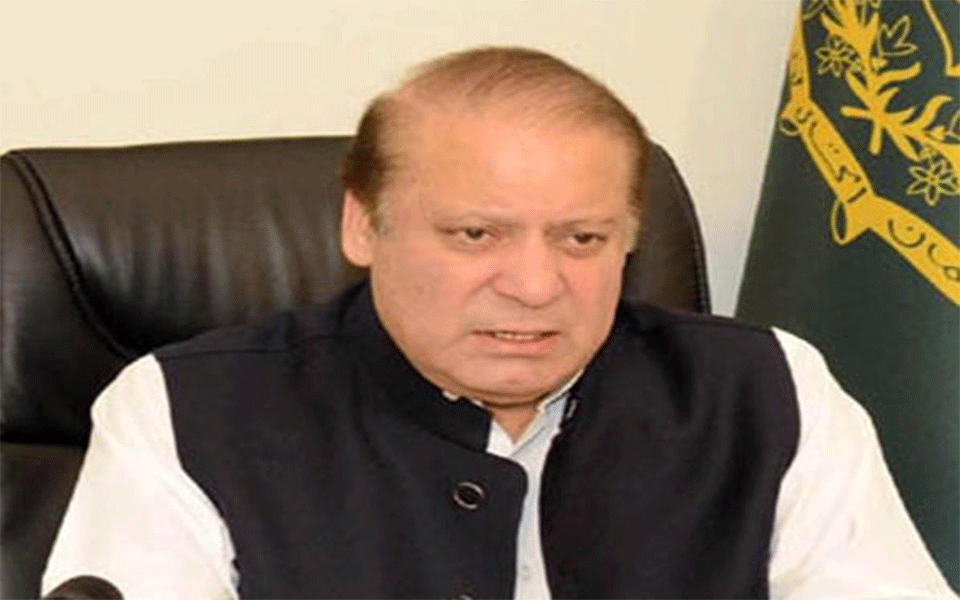Islamabad, July 14 : Former Pakistan Prime Minister Nawaz Sharif, daughter Maryam and her husband have decided to appeal against the July 6 verdict by an anti-corruption court. They were convicted and jailed for owning properties disproportionate to their sources of income.
Nawaz Sharif's legal team was allowed to meet him briefly a day after he was shifted to Adiala jail on the outskirts of Rawalpindi.
Sources said the legal team was allowed to meet for only five minutes. The Saad Hashmi-led legal team went to Sharif to get the power of attorney signed so that an appeal could be filed in the Islamabad High Court, they added.
No bed, no AC has been provided to Sharif in Adiala, the team said, adding that a senior police official was present throughout the meeting. Sharif was not even given a newspaper to read, his bed was a mattress on the floor and the washroom at his disposal was in despicable conditions.
The appeal by Maryam Nawaz and her husband Safdar Awan which will be filed on July 16 was drafted on Saturday. Maryam's legal team was still in Adiala jail to get the power of attorney but was unable to file the appeal before the court hours ended. Court hours last till 1 p.m. during summer vacations.
The appeal -- that highlights the legal flaws in the Avenfield judgement -- asks for the accountability court's verdict to be declared null and void. It further pleads that the sentence of Safdar Awan be suspended till a decision on the appeal is reached.
Sharif and his political heir Maryam were arrested at the Lahore airport late on Friday as they returned to the country in an attempt to rally for their beleaguered party days before the July 25 polls.
High drama surrounded the arrests as the authorities blocked roads, shut off mobile and internet services and deployed thousands of security forces to thwart supporters of the Sharifs from reaching the airport.
The police have arrested at least 600 workers of Sharif's party, Pakistan Muslim League-Nawaz, citing security-related charges in the past several days.
Officials from the National Accountability Bureau (NAB), the anti-corruption watchdog, placed the Sharifs under arrest. Sharif was allotted a 'B' class category in the prison.
According to sources in the know of developments, the plan regarding Sharif and daughter's stay at the jail was amended thrice after which it was decided to allot him a 'B' class jail.
It was also decided to keep Maryam in Adiala jail's women's cell and not in Sihala rest house as suggested earlier.
The trial of two remaining NAB cases against the Sharifs will take place in the jail, according to a government notification.
Besides, the Sharifs will also be tried in cases pertaining to the Al-Azizia Steel Mills and Hill Metal Establishment and offshore companies, including Flagship Investment Limited, inside the jail.
Meanwhile, the cabinet sub-committee also approved a request to put the three-time Prime Minister and his daughter on no-fly list.
The Sharifs have maintained that the cases are manufactured by their political foes and the country's powerful military.
Let the Truth be known. If you read VB and like VB, please be a VB Supporter and Help us deliver the Truth to one and all.
Mumbai (PTI): Rupee depreciated 9 paise to an all-time low of 90.58 against US dollar in early trade on Monday, weighed down by uncertainty over an India-US trade deal and persistent foreign fund outflows.
Forex traders said rupee is trading with a negative bias as investors are in wait and watch mode and awaiting cues from the India-US trade deal front.
At the interbank foreign exchange market, the rupee opened at 90.53 against the US dollar, then fell further to an all-time intraday low of 90.58 against the greenback, registering a fall of 9 paise over its previous close.
On Friday, the rupee had slipped 17 paise to close at an all-time low of 90.49 against the American currency.
Meanwhile, the dollar index, which gauges the greenback's strength against a basket of six currencies, was trading 0.05 per cent lower at 98.35.
Brent crude, the global oil benchmark, was trading higher by 0.52 per cent at USD 61.44 per barrel in futures trade.
On the domestic equity market front, the 30-share benchmark index Sensex was trading 298.86 points lower at 84,968.80, while the Nifty was down 121.40 points at 25,925.55.
Foreign Institutional Investors sold equities worth Rs 1,114.22 crore on Friday, according to exchange data.
"FPIs continue to be in selling mode in equity and debt while RBI has been selling dollars to fund their long positions," said Anil Kumar Bhansali, Head of Treasury and Executive Director Finrex Treasury Advisors LLP.





